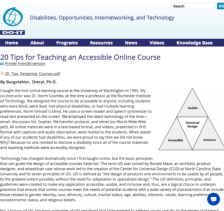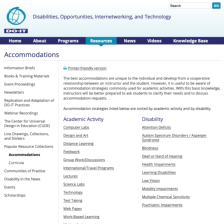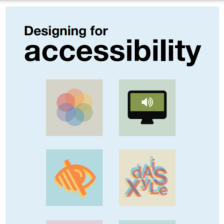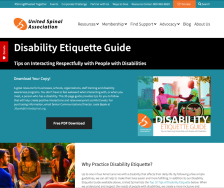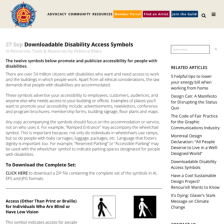Tools
Accommodations -- Best Practices
Resources | |
|---|---|
This resource was written by Sheryl Burgstahler, the founder of the DO-IT Center at University of Washington, and includes 20 tips on creating and teaching accessible online courses. Nine tips cover accessible technology and focus on course web pages, documents, images, and videos. Eleven tips cover instructional methods. This resource also...
This resource, from the Job Accommodation Network (JAN), is a database of information regarding disabilities and accommodations. "This information is designed to help employers and individuals determine effective accommodations and comply with Title I of the Americans with Disabilities Act (ADA). [Users] will find ADA information, accommodation...
This webpage, from the DO-IT (Disabilities, Opportunities, Internetworking, and Technology) website, includes links to accommodation strategies by academic activity and disability. "With this basic knowledge, instructors will be better prepared to ask students to clarify their needs and to discuss accommodation requests." Academic activities...
This toolkit, made available by BCcampus, is on online and open access textbook that provides "resources for each content creator, instructional designer, educational technologist, librarian, administrator, and teaching assistant to create a truly open textbook - one that is free and accessible for all students." The book is organized into two main...
This webinar, made available by Internet Scout Research Group, features Rachel Bower and Luis Perez discussing how institutions can increase the accessibility of high quality materials for learners with disabilities. The presentation is geared towards all educators in order to make designing for accessibility easy to understand and implement...
This set of seven posters from Home Office Digital list the dos and don'ts for designing web materials for users: (1) on the autistic spectrum; (2) of screen readers; (3) with low vision; (4) with dyslexia; (5) with physical or motor disabilities; (6) who are deaf or hard of hearing; and (7) with anxiety.
This booklet from the United Spinal Association provides tips for interacting more effectively with people who have disabilities. The booklet includes basic, terminology, and disability specific tips. Examples of basic tips include ask before you help, be sensitive about physical contact, and think before you speak. Some examples of terminology...
This website from the Graphic Artists Guild provides disability access symbols. These symbols are intended for users to advertise "... accessibility to employees, customers, audiences, and anyone else who needs access to [their] building or offices. Examples of places to promote accessibility include advertisements, newsletters, conference and...
This webpage, made available by CAST, Inc., provides information on how educators can support executive functioning in online learning environments. Executive functioning is defined as "a term used to describe a set of cognitive capabilities that influence behaviors" that includes:
setting appropriate goals
planning and organizing
developing...
This website includes guidelines for inclusive game design. This straightforward reference provides game design suggestions ranging from Basic (easy to implement, wide reaching and applies to almost all game mechanics), to Intermediate (requires some planning and effort), to Advanced (complex adaptations for profound impairments and specific niche...
| |
| Next → | |
